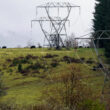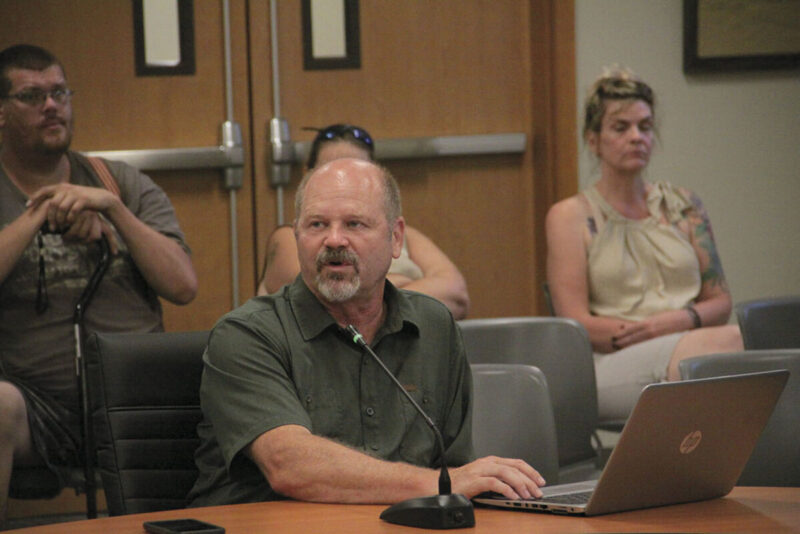Benny Westcott
The top choice for a location of a homeless shelter in Sweet Home that has emerged from a series of committee meetings in recent weeks is a seven-acre parcel of land behind Bi-Mart that currently belongs to the county.
The committee that has been seeking out answers to address the issue of homelessness includes Police Chief Jeff Lynn, Community Services Officer Sean Morgan, City Manager Ray Towry, Community and Economic Development Director Blair Larsen, and Shirley Byrd, executive director of the Family Assistance and Resource Center (FRC).
The FRC is a nonprofit organization that serves people experiencing homelessness in Linn County. Several members of the Community Health Committee that meets monthly in City Hall also take part in the subcommittee on homelessness.
The committee was tasked with finding a suitable place for a homeless shelter that would offer an alternative to the emergency cold weather shelter that was set up in the lawn outside of the Church of Nazarene this past winter.
Brock Byers, program manager at FRC, presented the committee’s findings to the Sweet Home Community Health Committee during its June 21 meeting at City Hall.
He said the intentions for the site behind Bi-Mart are to have a community center, huts, a small tent area, and some parking spaces for RV and car-type campers.
Byers said they are looking at a capacity of 30 huts, 15-20 tents, and 5-10 vehicles.
Of the community center, he said “This is a center that’s available for the community, not just the homeless, as a resource center into various services and service partners.”
As far as the huts, Byers said that the group is considering structures that don’t have power or heat, but that are “more substantial than tents.”
Byers said alcohol, illegal drugs, or weapons would be prohibited on the site, and failure to adhere to these rules would be grounds for immediate eviction.
“We want to make sure we’re not reinforcing those types of ideals,” he said.
He noted that not just anyone can come and go as they please in the plans for the facility.
“There’s guidelines, there’s rules, there’s an intake. So it’s not just a place for people to go to camp,” he said.
Byers termed the potential facility an “emergency sleep center.”
“I’m not going to call it a shelter. It’s not a shelter,” he said. “It’s really a place that people can put their heads at night, with an emphasis on services and case management activities. During the day, it’s not that they get to stay there. There isn’t that type of activity. We actually kind of kick the folks out, and we have services and activities for them.”
Byers said that he wants the sleep center to be “immediately accessible to those in need, and low-barrier, without prerequisites for entry.”
“This is just a temporary solution for individuals at this particular level that are in a low-barrier type environment,” he said of the center. “We want to work with them and transition them into transitional housing, and then in the future to permanent type housing.”
“A lot of the clients that we serve in this area tend to fall on the spectrum of low-barrier,” Byers explained, meaning that a lot of people don’t have the prerequisites such as ID and sobriety that would qualify them for “higher barrier” facilities. “So we want to be able to provide solutions for those individuals. If we always focus on the high-barrier, we’re not going to solve the issues that we’re facing here, of individuals in the streets and individuals in business entryways.”
“For the low-barrier, we may not have clean and sober,” he pointed out. “But that doesn’t mean that this is a lawless type solution. I want to emphasize that.”
Byers noted that the committee members considered the 2018 court decision Martin v. Boise in formulating their plans.
“Basically, it was a federal suit about what you can and can’t do if you have homeless camping on your street,” he said. “If we don’t have homeless environments or situations for our homeless, they have the right to rest.”
“We wanted to make sure in putting together this comprehensive solution that we provided a mechanism for the city of Sweet Home to be able to provide ‘right to rest’ in a safe, consolidated and compliant manner that meets regulations.”
Some other site considerations were that the site be within city limits, be suitable for camping, and be accessible for garbage and truck service. The availability of water and power were also considered.
Additionally, Byers said the committee evaluated proximity to schools and housing environments.
“We certainly didn’t want to locate near a school, and we wanted to be cognizant of our community in considering where we would like to house these individuals,” he said.
The committee plans on presenting the plan at an upcoming City Council meeting, where it would have to be approved by the council.
Additionally, county commissioners must sign off on allowing the county land to be used for this purpose. While the committee has yet to garner these necessary approvals, Byers already touched on time tables if things do move forward, saying that site prep could potentially start on the property in July.
“And I believe we could have an operational cold weather emergency center by this winter,” he said.
The homelessness situation in Sweet Home is subject to fluctuations, as many residents lack stable living situations.
“I am hearing through the school district that there are upwards of 300 houseless families in Sweet Home,” Byers said. “I say houseless, because they may be couch surfing, or may be staying with other families. Many have living situations, but that can change fairly rapidly.”
Byers noted the relative success of the emergency shelter at the Church of Nazarene this past winter.
“I didn’t sleep out there, and I can’t imagine sleeping in a tent in below-freezing weather, but believe it or not, it helped a lot of clients,” he said.
At its maximum population, the church’s tent camp was sheltering 34 people. It disbanded in mid-March.
Byers said he hopes that Sweet Home’s next homeless solution will help struggling individuals become contributing members of society.
“We want eventually to have our individuals give back to the community,” he said. “We want to encourage that involvement, and we want to do some gardening and some other things.”





